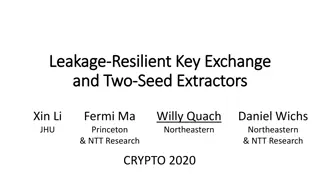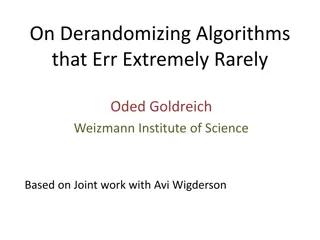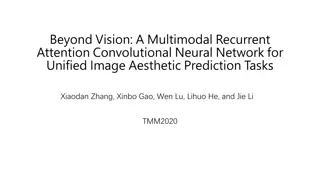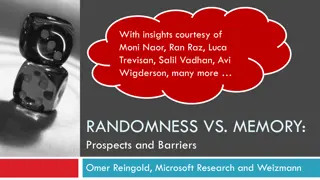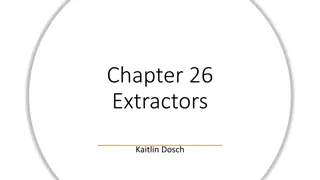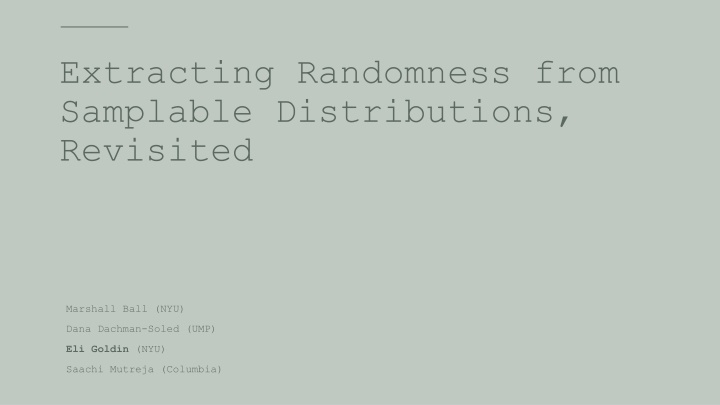
Exploring Randomness Extraction from Samplable Distributions
Discover how to flip a coin in a weakly random universe, the importance of randomness in algorithms and cryptography, and the key concepts of randomness extraction from high-entropy sources. Learn about known extractors, samplable sources, and the Church-Turing thesis extended. Uncover intriguing mathematical questions and the existence of efficient extractors for samplable sources.
Download Presentation

Please find below an Image/Link to download the presentation.
The content on the website is provided AS IS for your information and personal use only. It may not be sold, licensed, or shared on other websites without obtaining consent from the author. If you encounter any issues during the download, it is possible that the publisher has removed the file from their server.
You are allowed to download the files provided on this website for personal or commercial use, subject to the condition that they are used lawfully. All files are the property of their respective owners.
The content on the website is provided AS IS for your information and personal use only. It may not be sold, licensed, or shared on other websites without obtaining consent from the author.
E N D
Presentation Transcript
Extracting Randomness from Samplable Distributions, Revisited Marshall Ball (NYU) Dana Dachman-Soled (UMP) Eli Goldin (NYU) Saachi Mutreja (Columbia)
How can you flip a coin if the universe is weakly random?
We need randomness! Randomized Algorithms Cryptography 3
Randomness extraction [von Neumann 51] 5
Randomness extraction Ideal: For all X, Ext(X) is close to uniform Ext deterministic, efficient 6
Key point To get randomness extraction, we need an additional assumption about the high-entropy source X. 7
Known extractors Two-source Extractors Seeded Extractors [Chor Goldreich 88] [Nisan Zuckerman 96] 8
Big (Math) Question What is the most general restriction we can put on X and still get randomness extraction? 9
Samplable sources X is samplable by size-s circuits if there exists C of size s with Prr[C(r)=x] = Pr[X x] [Levin 86] [Trevisan Vadhan 00] 10
Extractors for samplable sources Informal Theorem: Modulo a complexity assumption, there exist efficient extractors for samplable sources. [Trevisan Vadhan 00] 11
Church-Turing thesis (strong, extended) 12
Church-Turing thesis (strong, extended) 13
Quantum CT thesis (strong, extended) 14
Quantum samplable sources X is samplable by size-squantum circuits if there exists quantumC of size s with Pr[C x]=Pr[X x] 16
Quantum extractor Informal Theorem: Modulo a complexity assumption, there exist efficient classical extractors for quantum samplable sources. 17
Classical improvement [TV00]: Builds extractors for samplable sources from a strong hardness assumption. We significantly weaken the assumption. 18
Assumptions Classical Assumption: E=DTIME[2O(n)] requires nondeterministic circuits of size 2 (n) nondeterminism and nonuniformity don t speed up all computation 19
Assumptions [TV 2000] Assumption: E=DTIME[2O(n)] requires 5-circuits of size 2 (n) 5-oracles and nonuniformity don t speed up all computation 20
Assumptions Quantum Assumption: E=DTIME[2O(n)] requires postselecting circuits of size 2 (n) quantum computing, postselection, and nonuniformity don t speed up all computation 21
Quantum worst-case Problem: no natural way to step up hardness against postselecting circuits. 25
Quantum worst-case Solution: Get rid of all the s! (i.e. better reduction) 26
Quantum worst-case Key tool: Gap Probability Maximization (GPM) 27
Gap probability maximization (GPM) 28
We can solve GPM For classical circuits: with an NP-oracle (hashing trick) For quantum circuits: using postselection 29
Final result Theorem: If f is hard for (nondeterministic/postselecting quantum) circuits, then h is an extractor for (classical/quantum) samplable sources. 31
Additional results Leakage-resilience Postselecting samplers 32
Open questions 1) Are our assumptions minimal? 2) Our error is 1/poly, can we get negligible? 3) We require Hmin(X)= (n), can we do better? Hmin(X)=logO(1)(n)? 4) Other places we can use this technique (GPM)? 33
Thank you! Full paper available at eligoldin.com 34

